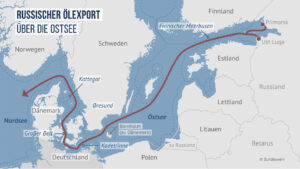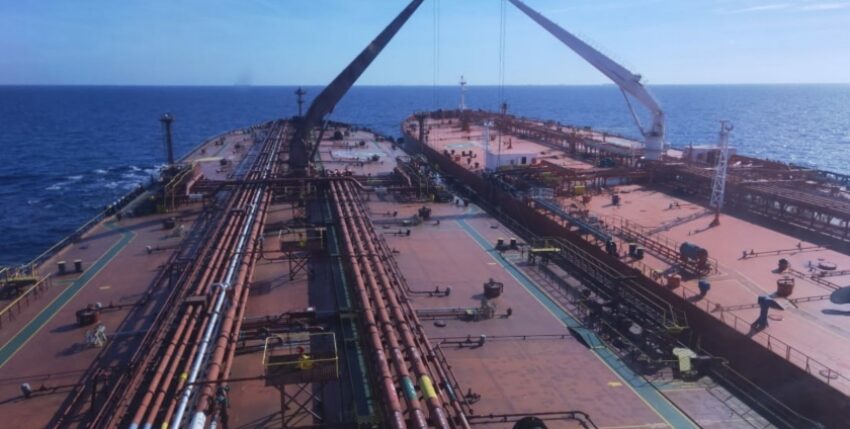An introduction to the term and its meaning
The term "Shadow Fleet" is frequently used and recently hit the headlines in connection with the involvement of Western shipping companies. We want to clarify the terminology and background. To this end, we are referring to an article by the Naval Shipping Administration, which deals with the special situation of the Russian shadow fleet in the Baltic Sea and was published on bundeswehr.org in the past few days. The article focuses on the Russian shadow fleet, which has come under increased scrutiny since the Russian invasion of Ukraine. However, other countries also maintain such constructs, as we will learn later. In addition to the aforementioned article from bundeswehr.org, our reporting is based on information from the EU, the IISS (International Institute for Strategic Studies), the OCCRP (Organised Crime and Corruption Reporting Project), the British shipping analyst Windward and other media. Unless otherwise stated, the analysed material is mostly dated 2024.
Sales to the Russian shadow fleet
According to the latest news, since the Russian invasion of Ukraine in 2022, European and US shipping companies have At least 230 older tankers sold to Russian, Russian-related and other ownersin order to Sudden increase in demand for tonnage to service. These sales generated income of over 6.3 billion US dollars for the owners. Shipping companies from Greece, the United Kingdom, Germany and Norway are particularly involved in these sales. The ships were often sold to buyers in countries such as India, Hong Kong, Vietnam and the Seychelles. The practice has Enables Russia to continue exporting oil while circumventing sanctions.

The revelation of this involvement of European companies sheds new light on the complex and illegal activities of the Russian shadow fleet and the continued disregard for international sanctions. The practice not only jeopardises the effectiveness of sanctions, but also poses a significant risk to maritime safety and environmental protection.
Shadow fleet: grey and black sheep
With the synonymously used terms "dark fleet" and "Shadow Fleet" describes a group of ships that engage in fraudulent practices. The renowned British platform Windward.ai, which analyses shipping issues, distinguishes between a grey and a dark part. The dark part is the group commonly referred to as the shadow fleet.
After that the grey fleet a completely new phenomenon that developed out of the Russian war. After the outbreak of the war, foreign companies were quickly established to disguise the origin and ownership of the ships and give the impression that they were law-abiding/sanctions-free. Windward describes this category as "grey" because it is often difficult to determine their legality and compliance with sanctions. A significant number of these vessels also change flags frequently ("Flag hopping"). This approach conceals the identity of Russian importers of crude oil and oil products. The import bans imposed on Russian oil in Western countries have brought new buyers into the market as prices have fallen. China, India, Libya and Turkey increased their trade. The grey fleet is trading quasi-legally, so to speak. Worldwide, over 1,000 grey ships transport. While 44 per cent of which oil product tankers are, make Crude oil tankers 31 per cent from.
The dark fleet uses disguising and deceptive practices to mask their intentions and the origin of their cargo and deliver it to the end customer undetected. This includes the deliberate deactivation or manipulation of the automatic identification system (AIS), inadequate freight documents or the manipulation of identity, origin, destination and location, including interference with the satellite navigation system. The fleet is characterised by ambiguous ownership structures and the changing use of several flags of convenience over short periods of time. Windward has over 1,300 Dark Fleet ships identified worldwide. The composition differs from the grey fleet: 43 per cent of the tankers in the dark fleet transport crude oil, 32 per cent oil products.
As with the grey fleet, the company points out that the volumes are constantly changing.
The global dimension of shadow flotillas: more than just a Russian phenomenon
Although the activities of NATO, the USA and the EU are primarily aimed at the Russian shadow fleet, whether grey or black, other countries also operate shadow fleets to circumvent sanctions. Especially the Iran, Venezuela and North Korea have established such fleets in recent years.
The Iran uses an extensive shadow fleet to export oil despite international sanctions. Typical tactics include switching off the AIS, ship-to-ship transfers on the open sea and the use of forged documents.
Similar to Iran, the Venezuela a shadow fleet to continue bringing its own oil to the world market. The ships circumvent sanctions by providing false position information and frequently changing flags. Ship-to-ship transfers and falsified freight documents are common practices.
The UN embargo against North Korea includes various measures aimed at preventing the transport of sanctioned goods such as coal and oil products. Pyongyang uses a shadow fleet to circumvent these sanctions. During IPD24, units of the German Navy took part in the international embargo efforts.
The activities of all these shadow fleets, including the Russian fleet, pose significant risks to maritime safety and the environment. The ships often have unclear ownership, are often old, in poor condition and inadequately maintained, which implies a certain risk of accidents and associated ecological damage. By switching off automatic identification systems (AIS), forging freight documents and carrying out ship-to-ship transfers on the open sea, the origin of the cargo (in the Russian case mostly oil and oil products, in the case of North Korea also coal) is concealed. Transhipment on the open sea also increases the risk of accidents and environmental disasters. Not using AIS inherently leads to a higher risk of accidents, especially in areas with high traffic volumes.
In focus: Russia
In connection with the concept of the shadow fleet, the current Russia Moscow has played a central role in this by circumventing international sanctions. Moscow has developed various methods to circumvent the price cap of USD 60 per barrel for Russian crude oil introduced by the G7 states and the EU. The tankers of the shadow fleet, which transport oil to countries such as China and India that are not bound by Western sanctions, play a central role. In addition to the measures already outlined to conceal the activities of the shadow fleet, Russia has started to provide its own insurance services for the tankers in order to reduce its dependence on Western insurers.
However, the circumvention strategies also have their price. The transport costs for Russian oil have risen, which reduces the profits from the oil business. However, the approach remains lucrative. In August 2023, Business Insider reported, citing the Financial Times, that Russia had made around 1.2 billion dollars through a loophole in the mechanism to limit the price of oil. This additional revenue was generated by increased transport costs that Moscow was able to charge for crude oil delivered to India.
Economic significance
Despite massive sanctions against Russia, the export of oil and oil products remains a significant source of income. Russia's gross domestic product (GDP) totalled around 2.121 trillion euros in 2023. Russia is heavily dependent on commodity exports, particularly oil and natural gas, which account for a significant proportion of GDP. Oil accounts for around 37 per cent and natural gas for 22 per cent of Russia's total gross domestic product. Viewed the other way round, exports from the energy sector account for around two thirds of Russia's total goods exports they carry the Half of government revenue. The shadow fleet helps Moscow to continue to generate considerable financial resources. According to the IISS, this fleet transports around 40 per cent of Russia's oil export volume.
As a result of the G7 decision, trade in Russian oil has increasingly shifted from traditional oil companies and commodity houses to other trading companies, fuelled by a gradually expanding 'dark fleet'. In the wake of Western sanctions, Russian trade in such products has expanded to China, India and Turkey. Moscow has opened up new customers for oil end products such as diesel in North and West Africa, the Middle East and Brazil.
Share of shadow fleets
The total volume of Russian crude oil and oil products transported by the dark and grey fleet since the start of the war amounts to over 142 million barrels per day (BPD) (as of May 2024). At an average annual price of USD 77 per barrel of crude oil in 2023 and assuming that the price cap of USD 60 was bypassed, Moscow made a profit of around USD 1.5 billion from the crude oil transported by these fleets. 6.1 billion US dollar. Following Russia's invasion of Ukraine, the volume of the grey fleet transported Russian freight increased by 79 per cent. In the dark fleet Russian freight transport has increased by 30 per cent compared to the time before the invasion.
Assessment of the naval shipping management
A major hub of the Russian oil trade is the Baltic Sea. The Naval Shipping Administration states: "Since the beginning of the Russian war of aggression, Russian shipping traffic in the Baltic Sea has decreased, but the number of journeys by loaded oil tankers has increased. Around 1,000 tankers transported crude oil and petroleum products from Russian Baltic Sea ports in 2023, according to research by Greenpeace transported. In December 2024 alone, the country is expected to transport Reuters exported around 5.5 million tonnes of oil products from its Baltic Sea ports. That is a share of over 50 per cent of total Russian oil product exports and is almost equivalent to Germany's monthly crude oil imports."
Overall, it is therefore hardly surprising that Moscow is investing in the shadow fleet. Reports show that considerable funds are being channelled into the purchase and maintenance of old ships. Although these investments do not necessarily strengthen the Russian economy as a whole, they primarily secure export capacities.
Tankers loaded with Russian oil often use the marked route from the two largest Russian Baltic Sea ports of Primorsk and Ust-Luga. Graphic: Bundeswehr/Mohr - Learn more
In a report published under the title "Baltic Sea: security risk of the Russian shadow fleet" published on the website of the Bundeswehr emphasises the Naval shipping management emphasises the serious dangers posed by this fleet, particularly in the Baltic Sea. Shadow fleet vessels frequently operate on routes from the Russian Baltic Sea ports of Primorsk and Ust-Luga and violate basic safety regulations. Their poor maintenance and disregard for standards significantly increase the risks of collisions, engine failures and environmental pollution.
A key safety risk emphasised in the Bundeswehr report is the lack of a functioning automatic identification system (AIS) on many of these ships. This makes them difficult to locate, which makes navigation more dangerous and potential collisions more likely. The inadequate communication systems on board are another problem that makes it considerably more difficult to react quickly in the event of an emergency.
The naval shipping management also cites specific incidents in which tankers from the shadow fleet attracted attention due to unsafe manoeuvres and blocked maritime trade routes. These ships often bypass checkpoints and avoid official reporting points, which significantly increases the monitoring effort. As many of these ships do not use local pilots and often sail without insurance, the risk of serious accidents increases.
The shallow water depths in certain areas of the Baltic Sea exacerbate the risk of collisions and oil spills. In addition, it is suspected that these vessels are involved in acts of sabotage against critical underwater infrastructure such as fibre optic cables and pipelines. Such incidents have caused significant disruption in the past and emphasised the need to strengthen security in the Baltic Sea.
The Bundeswehr emphasises the importance of increased vigilance and a stronger presence in the Baltic Sea in order to identify and counter potential threats from the shadow fleet. This includes both the monitoring of shipping traffic and co-operation with international partners.
Photo The US-sanctioned tanker "Elegance", now "Eminent". Reconnoitred by a German unit as part of a NATO North Atlantic Treaty Organisation support mission. Photo: Bundeswehr/Mühe - https://www.bundeswehr.de/de/ostsee-sicherheitsrisiko-schattenflotte-5883596
Reactions of the international community
The Russian shadow fleet is under strong Sanction pressure. The US, the UK and the EU have imposed a series of sanctions against Moscow's shadow fleet. Some countries have started to remove sanctioned Russian shadow tankers from their Registers to be cancelled. As a result, these ships lose their legal right to operate under the jurisdictions of the countries of registry.
NATO and the EU have stepped up their security measures in the Baltic Sea to counter the threats posed by the shadow fleet. In addition, Washington, London and Brussels have imposed sanctions on various elements of economic life. A note from the Maritime Administration: "The EU, US and UK sanctions lists include vessels directly associated with the shadow fleet, as well as vessels whose owners - individuals and companies - are sanctioned. There are 79 ships on the EU list, 59 of which are tankers. The USA has 183 ships on its sanctions list. Of these, 155 ships are tankers, 70 of which are allocated to the shadow fleet. Great Britain sanctions 110 ships. A comparison of the data shows a total of 291 sanctioned ships with a connection to Russia."
The challenges
The Russian shadow fleet remains a significant risk to maritime security, the environment and geopolitical stability in Europe. Its activities must be monitored and prevented more effectively.
A recent incident in Norway illustrates the international dimension of the problem and the need for stricter controls. On 29 January 2025, the LNG tanker "North Light" was escorted to the Norwegian port of Honningsvåg on its way from South Korea to Murmansk. The brand-new ship, flagged Singapore, is suspected of wanting to load LNG at a Russian loading station in the Arctic.
The incident shows the increasing international diversification of the shadow fleet, which does not even stop at Arctic waters. Their complex operations often frustrate international efforts to monitor and control such activities.
On the other hand, the European Union must ask itself to what extent its measures are working. After all, it is significant that 12 per cent of the ships in the dark fleet sail under the European flag. A look at the ownership structure is also disconcerting: In May 2024, 31 per cent of the ships in the dark fleet belonged to Europe (with Windward recording an increase of 11 per cent since March 2023). Greece accounts for 47.6 per cent of grey ships and 36.1 per cent of dark ships - both with increases of 30 and 22 per cent respectively compared to March 2023.
A sign of dwindling determination, a lack of understanding of solidarity or perhaps an indication that there is still a long way to go before words are followed by deeds.










